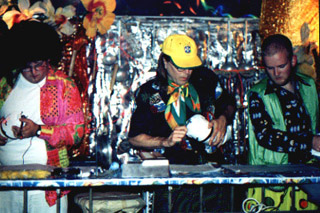- Wrenchophones

(Photo: Ann Talley)
Performing at the Schmalzwald, Berlin,
l. to r.: Alex Ruthmann, Stephen Rush, Chris Peck.
Sewer pipes, doorbell buttons, speakers, wrenches,
PIC microcontrollers, ISD sound chips.
Stephen Rush and Michael Rodemer.*
1999, ongoing.
Wrenchophones are what one gets after crossing microcontrollers, sewer pipes,
sound chips, and a Dada-esque sensibility. The Wrenchophones are sculptural assemblages
that function as sample players, with output either through a built-in speaker, or
through an external sound system. A collaboration between sculptor Michael Rodemer
and composer Stephen Rush, they consist of large PVC-pipe elbows, with quite conventional
and industrial-looking wrenches mounted on the ends. The pipes contain a PIC microcontroller
and ISD sound chips that store and play back four sets of sounds. On the side of
the pipe are mounted an on/off switch, a 1/4” audio jack, and 4 conventional doorbell
buttons, which select one of four 30-second samples stored on the ISD chips. Each
“W-phone” has a different set of sounds stored within. The wrench lets one play through
each sample smoothly, or from any spot in the sample (depending on the rotation of
the wrench), and plays loops if the wrench remains stationary. A second version of
Wrenchophones for concerts has been created which uses MAX, MSP, a sound sampler,
and an EZ I/O interface board linked to the doorbell buttons and the wrench-potentiometer.
The current compact version of Wrenchophones contains “NOISE” samples, very grungy
and loud. The sound sets of the Wrenchophones, however, are continually being changed
by the artists and their collaborating performers – the sounds sometimes include
pure tones, lawn mowers, motors revving up, birds singing, people talking.
The piece demonstrates a kind of marriage between Art and Industry, using industrial
tools and sound to create music or art. In one way the work is an extension of early
Dadaist art (Duchamp, Arp, et al), but is also a completion of a lineage of American
music-making that integrates “noise” elements into the fabric of music composition
(John Cage and Lou Harrison). Another charm of the piece is certainly the spontaneous
joy of the players/visitors as they “play” the wrenches, discovering musical possibilities
and sonic problems as they interact with the sculpture.
We can offer Wrenchophones both as an installation for visitor participation, and as a concert event, either on stage or in "guerrilla" format.
* with thanks to Matt Undy, Chris Peck, and Greg Jacobs for grabbing hold and
helping out.
